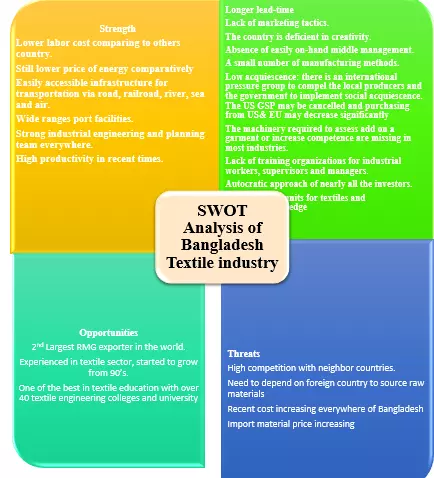Finding strength is not merely the measurement of doing the right. Rather it explores operational disguise and inertia. The Textile Industry Market involves business criteria, productive segmentation, supply and demand, market research, new competitors and patterns, etc. The SWOT analysis is mostly used tool to research textile and apparel industry performance in the world through which no single criteria will be out of the analysis of whether a company seeks their present operational benchmark.
What is SWOT analysis?
The SWOT analysis is a measurement tool to overlook formal and informal attributes including possible risks in a company or organization which may contribute to the company’s relative merits and demerits. So, this tool will involve planning, organizing, staffing, decision making, co-operating channel, task recording and reporting, and financing to develop a full assumption so that the further pattern of actions may be easier. The method was innovated in the 1960s by Albert Humphrey of the Stanford Research Institute, during a study conducted to identify why corporate planning consistently failed. This tool may be used in both public and private organizations. It finds a mirror to see organizational performance and capacity.
Why SWOT?
Moreover, SWOT analysis is conducted to identify organizational current status and business growth in comparison with operational vision and new competitors. SWOT analysis discovers recommendations and strategies, with a focus on leveraging strengths and opportunities to overcome weaknesses and threats. It’ll show you the key areas where your organization is performing optimally, as well as which operations need adjustment.
When SWOT?
SWOT analysis should before you commit to any sort of company action, whether you are exploring new initiatives, revamping internal policies, considering opportunities to pivot, or altering a plan midway through its execution.
Who are the actors of SWOT?
All the stakeholders might be involved in the analysis process to get a clear picture of company performance and growth. Business owners and team members may include at a time to obtain a variety of ideas and perceptions; then discuss their particular contributions openly. The collective knowledge of the team will allow you to adequately analyze your business from each perspective.
Understanding SWOT in regard to Textile Industry
The abbreviation of SWOT energized with four enthusiastic words – Strength, Weakness, Opportunities, and Threat in which the first two cover internal factors and the second two cover external factors of the company respectively. This tool can be applied to an entire company or organization, or particular projects in a department. Here we refer Textile industry is as Yarn manufacturing (Spinning), Thread manufacturing, weaving, knitting, dyeing-printing industry, and the apparel industry. Among them, apparel is the leading side of Bangladesh, Bangladesh is the 2nd largest exporter in RMG.
Bangladesh Textile Industry
Remarkable socio-economic development appears in the garments industry due to the vast employment opportunities for marginal people. They act as a driving force of the glorious tag ‘Made in Bangladesh’. The country’s export-oriented (RMG) units employ around 2.7 million workers, as per a new survey conducted for digital mapping of the industry. The ratio of male and female workers now stands at 42:58 in the multibillion-dollar industry that earned US$31.45 billion in the last fiscal year (MUNNI, 2022). More than 80% of the labor force in garment factories in Bangladesh are female. So, it’s not hard to rank on the top if managerial and employee welfare gets desired procedures. And attractive Participation in this sector may work as a tool to boost the industrial SWOT.

SWOT Analysis of Bangladesh Textile Industry
Strength of Bangladesh Textile Industry:
- Lower labor cost compared to other countries.
- Still the lower price of energy comparatively
- Easily accessible infrastructure for transportation via road, railroad, river, sea, and air.
- Wide ranges of port facilities.
- Strong industrial engineering and planning team everywhere.
- High productivity in recent times.
Weakness of Bangladesh Textile Industry:
- Longer lead-time
- Lack of marketing tactics.
- The country is deficient in creativity.
- Absence of easily on-hand middle management.
- A small number of manufacturing methods.
- Low acquiescence: there is an international pressure group to compel the local producers and the government to implement social acquiescence. The US GSP may be canceled and purchasing from US& EU may decrease significantly
- The machinery required to assess add-on a garment or increase competence is missing in most industries.
- Lack of training organizations for industrial workers, supervisors, and managers.
- The autocratic approach of nearly all the investors.
- Fewer process units for textiles and garments.
- Sluggish backward or forward blending procedure.
- Incompetent ports, entry/exit complicated, and loading/unloading take much time.
- Speed money culture.
- Time-consuming custom clearance.
- Unreliable dependability regarding Delivery/QA/Product knowledge.
Opportunities for the Bangladesh Textile Industry
- 2nd Largest RMG exporter in the world.
- Experienced in the textile sector, started to grow in the ’90s.
- One of the best in textile education with over 40 textile engineering colleges and university
Threats of Bangladesh Textile Industry
- High competition with neighboring countries.
- Need to depend on foreign countries to source raw materials
- Recent costs increasing everywhere in Bangladesh
- Import material prices increasing
References:
- MUNNI, M., 2022. 2.7m apparel workers on database. [online] The Financial Express. Available at: <https://thefinancialexpress.com.bd/trade/27m-apparel-workers-on-database-1638845850> [Accessed 5 June 2022].
- Schooley, S., 2022. SWOT Analysis: Definition and Examples – businessnewsdaily.com. [online] Business News Daily. Available at: <https://www.businessnewsdaily.com/4245-swot-analysis.html> [Accessed 5 June 2022].
